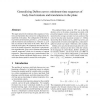Free Online Productivity Tools
i2Speak
i2Symbol
i2OCR
iTex2Img
iWeb2Print
iWeb2Shot
i2Type
iPdf2Split
iPdf2Merge
i2Bopomofo
i2Arabic
i2Style
i2Image
i2PDF
iLatex2Rtf
Sci2ools
113
Voted
IJRR
2010
2010
Generalizing Dubins Curves: Minimum-time Sequences of Body-fixed Rotations and Translations in the Plane
This paper presents the minimum-time sequences of rotations and translations that connect two configurations of a rigid body in the plane. The configuration of the body is its position and orientation, given by (x, y, ) coordinates, and the rotations and translations are velocities ( x, y, ) that are constant in the frame of the robot. There are no obstacles in the plane. We completely describes the structure of the fastest trajectories, and present a polynomialtime algorithm that, given a set of rotation and translation controls, enumerates a finite set of structures of optimal trajectories. These trajectories are a generalization of the well-known Dubins and Reeds-Shepp curves, which describe the shortest paths for steered cars in the plane.
| Added | 05 Mar 2011 |
| Updated | 05 Mar 2011 |
| Type | Journal |
| Year | 2010 |
| Where | IJRR |
| Authors | Andrei A. Furtuna, Devin J. Balkcom |
Comments (0)

